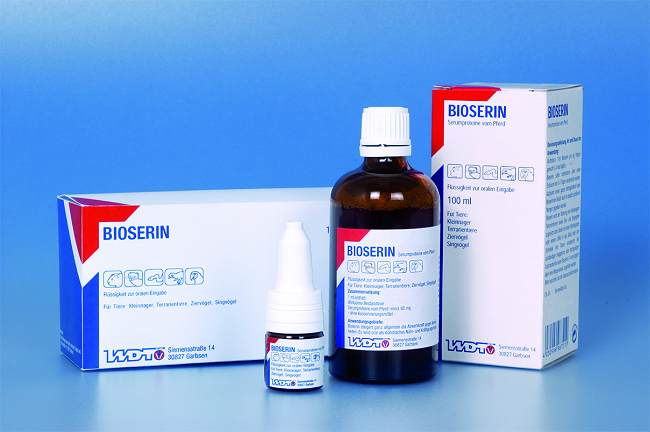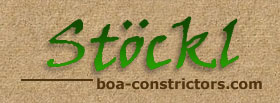In our last book (Your Hobby – Boas and Pythons), we documented our experiences with Boviserinâ, an amino acid concentrate that is produced from the blood of cattle, in detail.
Unfortunately, this product was taken off the market due to the BSE (Bovine Spongiform Encephalopathy) issues, just as our book left the print shop (perfect timing).
While that circumstance was just unfortunate, the fact that this created a therapeutic gap in regard to the treatment of sick boas that long remained unfilled, was much worse.
Finally, an equally effective product, Bioserin (by the „Wirtschaftsgenossenschaft deutscher Tierärzte [WDT]“), is now available. In Bioserin, the proteins are produced from horses rather than from cattle. It was first released in October 2001, and is available at pharmacies and veterinarians.
If used as directed, Bioserin is well tolerated, can be administered by the keeper himself/herself, and is of broad therapeutic usage. We therefore think that it is worth discussing this substance in detail. Following are now our experiences with the use of Bioserin in boids, as well as the areas of application that we applied it in:
- Bacterial infections of the gastrointestinal tract
- Digestive problems in young snakes, caused by an insufficiency of the digestive apparatus (regurgitation syndrome)
- Lack of appetite and Cachexia
- Increase in natural resistance against infections
- Improvement of overall health condition
- Increase in weight
To point 1:
Even in the early stage of an infection with Pseudomonas aeroginosa or Proteus ssp., boas refuse to feed and quickly lose weight. In addition to the treatment with antibiotics following a resistance test, an administration of 0.5 -1.0ml per 100g of snake, with a maximum of 15.0ml every other day over a period of 14 days is recommended.
An orally effective antibiotic can be administered in conjunction with Bioserin through a catheter.
Animals treated in that manner usually do not lose any further weight, and – following the completion of the antibiotic treatment – start accepting food again sooner than otherwise would be the case.
To point 2:
Some young snakes in their first year of life have the tendency of regurgitating their food. You have already read about this in more detail in the section about the regurgitation syndrome.
The digestive apparatus becomes increasingly sensitive through the repeated regurgitations, which leads to it finally being unable to retain anything at all.
Bioserin can contribute to the convalescence of the young snake. After or during the treatment with the effective medication determined by the vet, the reptile can be additionally treated with administrations of 0.5-1 of Bioserin per 100g of bodyweight every third day via catheter for a period of 14 days. After this treatment and a subsequent break of 2 weeks, the condition of the snake is stable enough for it to feed on pinkie mice without regurgitating them.
Then, larger prey items can gradually be offered over time.
Boa constrictor Bioserin | buy Bioserin | Bioserin treatment | Bioserin drugstore | Bioserin reptiles | Bioserin Boa constrictor | Bioserin application on Boa constrictor | Bioseriun dose | administer Bioserin | oral protein solution Bioserin
To point 3:
You have also already read about the problems concerning wild-caught specimens. The stress caused by the catching and shipping processes, as well as the numerous changes of location and usually insufficient husbandry conditions have a devastating effect on the animal’s willingness to feed.
Even veterinary care is often unable to change this. When dosed as described under point 1, Bioserin leads to the stabilization of the bodyweight and in some circumstances even to a slight gain in weight by stimulating the appetite of the animals, which then results in them feeding again shortly (assuming that all diseases and parasites have been treated accordingly).
Should this not be the case and the condition of the animal requires doing so, the administration of Bioserin may be repeated after 14 days.
To point 4:
In our report that was sent to Hoechst Roussel Vet in August 1998, we already surmised that Boviserinâ leads to an increased natural resistance against infections. The directions of Bioserin now state this in black and white: „Bioserin generally increases the natural resistance against bacteria“.
We think that this is clearly stated and welcome information. However, it would not make sense to stuff well-feeding boas with catheters, just to strengthen the immune system with Bioserin.
The stress could void any potential positive effects. For this, there is a much simpler and for the snake much more comfortable method of administration: Bioserin is injected into a dead prey item and thereby serves as a nutritional supplement. By injecting a dosage as described in point 1 every second or third feeding, you are on the safe side.
To point 5:
The supplementation of the food, as described in point 4, leads to an improved overall condition of the animals. It can be observed how the scales are much shinier and the coloration is much more evident, which documents a good health condition.
To point 6:
Any weight lifter will confirm that amino acid (in form of pills or drink) adds a few pounds of muscle mass to the body. With a protein concentrate such as Bioserin, the anabolic metabolism is stimulated, causing the animal to grow at a faster rate. However, do not overdo this! One hint for bodybuilders: Get your own supplements that stuff belong to the snakes!
 Bioserin can be purchased from vets and pharmacies in Germany
Bioserin can be purchased from vets and pharmacies in Germany
